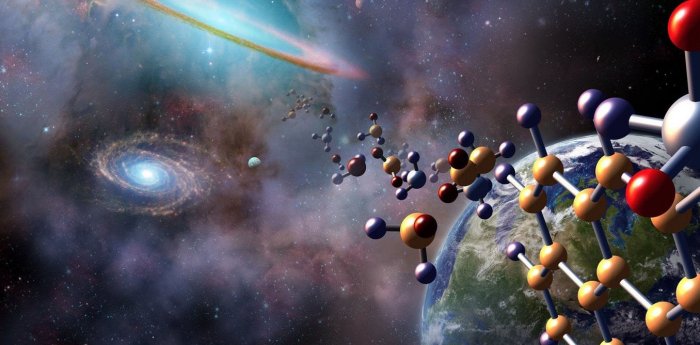‘RNA World’ Hypothesis Questioned: Alternate Theory Of How Life Started Proposed by Scientists
– A group of scientists have presented an alternate theory of how life on Earth started about four billion years ago.
The current the “RNA world” hypothesis, is based on the assumption that RNA molecules evolved to create proteins and DNA, but not all scientists are convinced this is what happened in the distant past. The new study questions the current “RNA world” hypothesis and researchers present evidence that show how RNA and DNA evolved simultaneously.

“Even if you believe in a RNA-only world, you have to believe in something that existed with RNA to help it move forward,” said Ramanarayanan Krishnamurthy, associate professor of chemistry at TSRI and senior author of the new study. “Why not think of RNA and DNA rising together, rather than trying to convert RNA to DNA by means of some fantastic chemistry at a prebiotic stage?”
The RNA World hypothesis has been investigated for over 30 years. In the early 1980s, a group of scientists led by Sidney Altman and Thomas Cech independently found that RNAs can also act as catalysts for chemical reactions. This class of catalytic RNAs are known as ribozymes, and the finding earned Altman and Cech the 1989 Nobel Prize in Chemistry.
The discovery of ribozymes supported a hypothesis, known as the RNA World Hypothesis.
The idea behind this theory is that a series of chemical reactions led to the formation of self-replicating RNA molecules. RNA then evolved to create proteins and enzymes that resembled early versions of what makes up life today. Eventually, these enzymes helped RNA produce DNA, which led to complex organisms.
On the surface, RNA and DNA molecules look similar, with DNA forming a ladder-like structure (with nucleobase pairs as the rungs and sugar molecule backbones as the sides) and RNA forming what looks like just one side of a ladder.
If the RNA world theory is accurate, some researchers believe there would have been many cases where RNA nucleotides were mixed with DNA backbones, creating “heterogeneous” strands. If stable, these blended “chimeras” would have been an intermediate step in the transition to DNA.
Hiwever, the new study conducted by scientists at The Scripps Research Institute (TSRI) reveals there is a significant loss of stability when RNA and DNA share the same backbone. The chimeras do not stay together as well as pure RNA or pure DNA, which would compromise their ability to hold genetic information and replicate.
“We were surprised to see a very deep drop in what we would call the ‘thermal stability,’” said Krishnamurthy, who in addition to his position at TSRI has joint appointments with the National Science Foundation (NSF)-National Aeronautics and Space Administration (NASA) Center for Chemical Evolution and the Simons Collaboration on the Origins of Life. This instability appeared to be due to a difference in the DNA sugar molecule structure versus the RNA sugar molecule.The finding supported previous research from Nobel laureate and Harvard University Chemistry and Chemical Biology Professor Jack Szostak that showed a loss of (nucleotide-binding aptamer) function when RNA mixed with DNA.
Because of this instability, chimeras in the RNA world would have likely died off in favor of more stable RNA molecules. This reflects what scientists see in cells today: If RNA nucleobases mistakenly join a DNA strand, sophisticated enzymes will rush to fix the mistake. Evolution has led to a system that favors more stable, “homogeneous” molecules.
These sophisticated enzymes were probably not around at the time of RNA and DNA’s early evolution, so these substitutions may have had a crippling effect on the molecules’ ability to replicate and function. “The transition from RNA to DNA would not have been easy without mechanisms to keep them separate,” said Krishnamurthy.
It is not the first time this alternate theory is proposed, but the new study provides scientists with more evidence that should be examined in detail.
If the RNA and DNA evolved at the same time, DNA could have established its own homogeneous system early on. RNA could have still evolved to produce DNA, but that may have occurred after it first met DNA and got to know its raw materials.
Of course, the researchers also point out we will never know exactly how life began (barring the invention of a time machine), but by considering circumstances of early evolution, scientists can gain insights into the fundamentals of biology.



 Creators of mankind
Creators of mankind Description of “Tall white aliens”
Description of “Tall white aliens” Where they came from?
Where they came from? About hostile civilizations
About hostile civilizations The war for the Earth
The war for the Earth “Tall white aliens” about eternal life
“Tall white aliens” about eternal life Video: “Nordic aliens”
Video: “Nordic aliens” Aliens
Aliens Alien encounters
Alien encounters The aliens base
The aliens base UFO
UFO Technology UFO
Technology UFO Underground civilization
Underground civilization Ancient alien artifacts
Ancient alien artifacts Military and UFO
Military and UFO Mysteries and hypotheses
Mysteries and hypotheses Scientific facts
Scientific facts


















